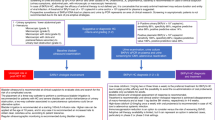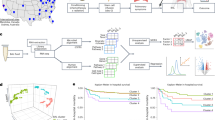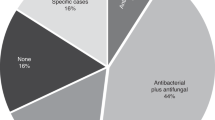Abstract
Infections are frequently experienced complications for patients undergoing haematopoietic cell transplant (HCT). To assess current infection prevention strategies, an international survey among HCT nurses was conducted by the Nurses Group and IDWP of the EBMT. Nurse representatives from all EBMT transplant centres were invited to complete an online questionnaire on protective environment in adult and paediatric HCT units. A total of 141 complete questionnaires were returned for the isolation section and 26 for the paediatric section, the majority of respondents (89.4%) being nurses. A small number of centres (7.1%) reported not allowing visitors, the rest have rules for entering patient rooms. Most HCT units (99.3%) indicated that nurses play a critical role in infection prevention and measures differed between bacterial infections and viral infections. Many of the paediatric units (57.7%) had a play area, applying rules of entry. To our knowledge, this is the first survey on protective environment directed at nurses within HCT centres. Despite having different practices, most HCT units tend to decrease isolation procedures and the use of PPE for multi-drug resistant organisms. This must concur with an increase of hand hygiene compliance, for which our data show that there is still room for improvement.
This is a preview of subscription content, access via your institution
Access options
Subscribe to this journal
Receive 12 print issues and online access
$259.00 per year
only $21.58 per issue
Buy this article
- Purchase on SpringerLink
- Instant access to full article PDF
Prices may be subject to local taxes which are calculated during checkout




Similar content being viewed by others
References
Tomblyn M, Chiller T, Einsele H, Gress R, Sepkowitz K, Storek J, et al. Guidelines for preventing infectious complications among hematopoietic cell transplantation recipients: a global perspective. Biol Blood Marrow Transpl. 2009;15:1143–38.
Girmenia C, Bertania A, Picciocchi A, Perruccio K, Algarotti A, Busca A, et al. Incidence, risk factors and outcome of pre-engraftment gram-negative bacteremia after allogeneic and autologous hematopoietic stem cell transplantation: an Italian prospective multicenter survey. Clin Infect Dis. 2017;65:1884–96.
Mikulska M, Raiola AM, Galaverna F, Balletto E, Borghesi ML, Varaldo R, et al. Pre-engraftment bloodstream infections after allogeneic hematopoietic cell transplantation: impact of T Cell-Replete transplantation from a haploidentical donor. Biol Blood Marrow Transpl. 2018;24:109–18.
Centers for Disease Control and Prevention. Guideline for hand hygiene in health-care settings: recommendations of the Healthcare Infection Control Practices Advisory Committee and HICPAC/SHEA/APIC/IDSA Hand Hygiene Task Force. MMWR Recomm Rep.. 2002;51:1–48.
WHO. WHO guidelines on hand hygiene in health care. 2009. https://www.who.int/gpsc/5may/tools/who_guidelines-handhygiene_summary.pdf. Accessed 9 March 2020.
Centers for Disease Control and Prevention, Infectious Disease Society of America & American Society of Blood and Marrow Transplant. Guidelines for preventing opportunistic infections among hematopoietic stem cell transplant recipients. MMWR Recomnm Rep.2000;49:1–125.
Schlesinger A, Mical P, Gafter-Gvili A, Rubinovitch B, Leibovici L. Infection-control interventions for cancer patients after chemotherapy: a systematic review and meta-analysis. Lancet Infect Dis. 2009;9:97–107.
Yokoe D, Casper C, Dubberke E, Leee G, Muñoz P, Palmore T, et al. Infection prevention and control in health-care facilities in which heamatopoietic cell transplant recipients are treated. Bone Marrow Transpl. 2009;44:495–507.
Rump B, Timen A, Verweij M, Hulscher M. Experiences of carriers of multidrug-resistant organisms: a systematic review. Clin Microbiol Infect. 2019;25:274–79.
Magiorakos AP, Srinivasan A, Carey RB, Carmeli Y, Falagas ME, Giske CG, et al. Multidrug-resistant, extensively drug-resistant and pandrug-resistant bacteria: an international expert proposal for interim standard definitions for acquired resistance. Clin Microbiol Infect. 2012;18:268–81.
CDC, 2019. https://www.cdc.gov/infectioncontrol/guidelines/isolation/index.html. Accessed 25 March 2020.
Fenelon LE. Protective isolation: who needs it? J Hosp Infect. 1995;30:218–22.
Biagioli V, Piredda M, Mauroni MR, Alvaro R, De, Marinis MG. The lived experience of patients in protective isolation during their hospital stay for allogeneic haematopoietic stem cell transplantation. Eur J Oncol Nurs. 2016;24:79–86.
Biagioli V, Piredda M, Alvaro R, De Marinis MG. The experiences of protective isolation in patients undergoing bone marrow or hematopoietic stem cell transplantation: systematic review and metasynthesis. Eur J Cancer Care. 2017;26: https://doi.org/10.1111/ecc.12461.
Munoz-Price LS, Banach DB, Bearman G, Gould JM, Leekha S, Morgan DJ, et al. Isolation precautions for visitors. Infect Control Hosp Epidemiol. 2015;36:747–58.
Stoll P, Silla LM, Cola CM, Splitt BI, Moreira LB. Effectiveness of a Protective Environment implementation for cancer patients with chemotherapy-induced neutropaenia on fever and mortality incidence. Am J Infect Control. 2013;41:357–59.
Styczynski J, Tridello G, Donnlly JP, Iacobelli S, Hoek J, Mikulska M, et al. Protective environment for hematopoietic cell transplant (HSCT) reecipients: The Infectious Diseases Working Party EBMT analysis of global recommendations on health-care facilities. Bone Marrow Transpl. 2018;53:1131–38.
Mank A, van der Lelie H. Is there still an indication for nursing patients with prolonged neutropenia in protective isolation? An evidence-based nursing and medical study of 4 years experience for nursing patients with neutropenia without isolation. Eur J Oncol Nurs. 2003;7:17–23.
Allegranzi B, Gayet-Ageron A, Damani N, Bengaly L, McLaws ML, Moro ML, et al. Global implementation of WHO’s multimodal strategy for improvement of hand hygiene: a quasi-experimental study. Lancet Infect Dis. 2013;13:843–51.
Anwar MM, Elareed HR. Improvement of hand hygiene compliance among health care workers in intensive care units. J Prev Med Hyg. 2019;60:E31–E35.
Oliveira AC, Gama CS, Paula AO. Multimodal strategy to improve the adherence to hand hygiene and self-assessment of the institution for the promotion and practice of hand hygiene. J Public Health. 2018;40:163–68.
Bruchez SA, Duarte GC, Sadowski RA, da Silva Filho AC, Fahning WE, Belini Nishiyama SA, et al. Assessing the Hawthorne effect on hand hygiene compliance in an intensive care unit. Infect. Prev Pract. 2020:2. https://doi.org/10.1016/j.infpip.2020.100049.
Maechler F, Schwab F, Hansen S, Fankhauser C, Harbarth S, Huttner B, et al. Contact isolation versus standard precautions to decrease acquisition of extended-spectrum ß-lactamase-producing Enterobacterales in non-critical wards: a cluster-randomised crossover trial. Lancet Infect Dis. 2020;20:575–84.
Ford CD, Lopansri BK, Gazdik MA, Webb B, Snow GL, Hoda D, et al. Room contamination, patient colonization pressure, and the risk of vancomycin-resistant Enterococcus colonization on a unit dedicated to the treatment of hematologic malignancies and hematopoietic stem cell transplantation. Am J Infect Control. 2016;44:1110–15.
Radanovich LJ Jr, Simberkoff MS, Bessesen MT, Brown AC, Cummings DAT, Gaydos CA, et al. N95 respirators vs medical masks for preventing influenza among health care personnel: a randomized clinical trial. JAMA. 2019;322:824–33.
Acknowledgements
We are extremely grateful to all nurses and other colleagues of EBMT centres who filled out the survey. Thanks for the time.
Author information
Authors and Affiliations
Consortia
Contributions
IA, TNB, MC, ECG, JacS, DA, MM, LG, JS, SJL, PVB conceptualised and designed the study. AEK collected the survey responses and KB performed the data analysis. IA, JS, DA, DH, JacS interpreted the results. IA has been the primary person responsible for writing the manuscript. IA, JS, AEK, KB, DA, JacS, DH, MM, TNB, MC, ECG, PVB, LG, SJL, JM, were involved in drafting the work or revising it critically for important intellectual content. All authors approved the final version to be published and agree to be accountable for all aspects of the work.
Corresponding author
Ethics declarations
Conflict of interest
The authors declare that they have no conflict of interest.
Additional information
Publisher’s note Springer Nature remains neutral with regard to jurisdictional claims in published maps and institutional affiliations.
Supplementary information
Rights and permissions
About this article
Cite this article
Agreiter, I., Kozijn, A.E., Bakunina, K. et al. Contribution of nurses to protective environment in haematopoietic cell transplant setting: an international survey by the European Society for Blood and Marrow Transplantation. Bone Marrow Transplant 56, 1433–1440 (2021). https://doi.org/10.1038/s41409-020-01194-6
Received:
Revised:
Accepted:
Published:
Issue date:
DOI: https://doi.org/10.1038/s41409-020-01194-6
This article is cited by
-
Infection prevention practices among EBMT hematopoietic cell transplant centers: the EBMT Infectious Disease Working Party survey
Bone Marrow Transplantation (2023)



